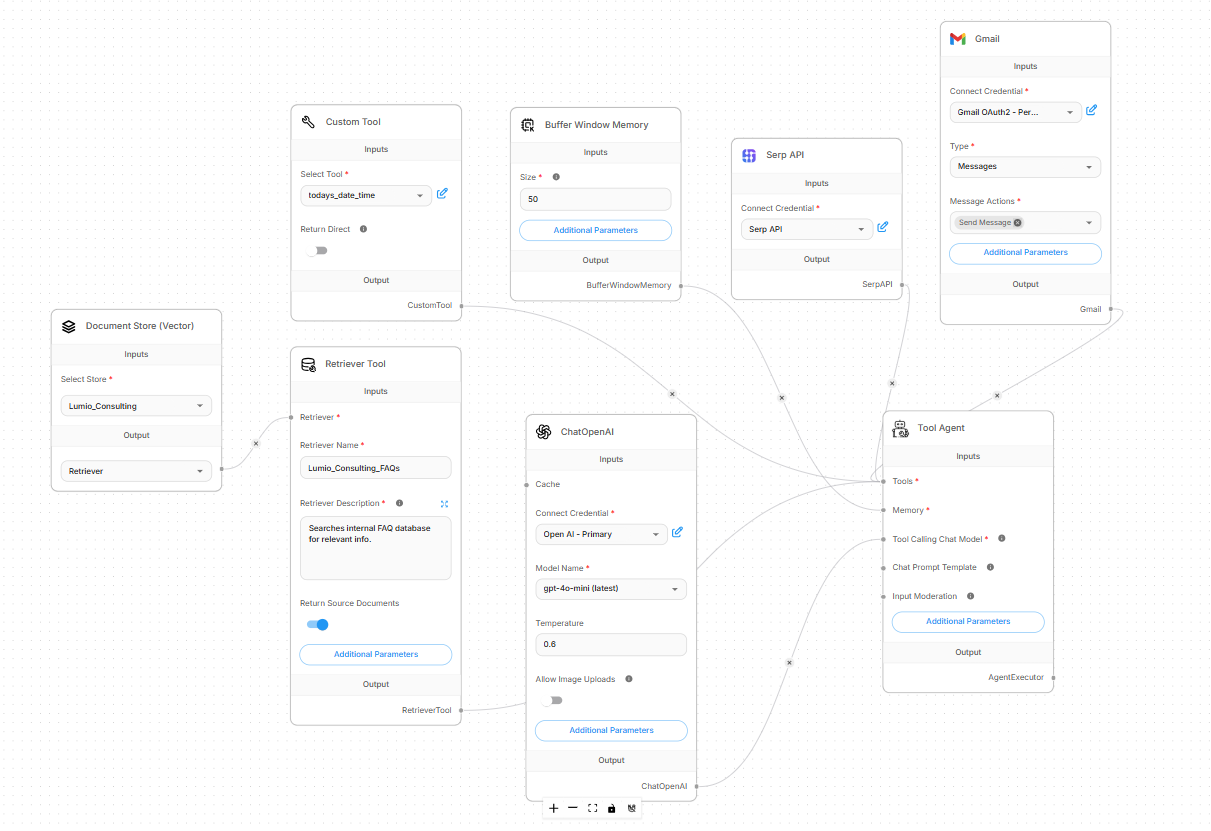Case Study: AI- Powered Website Chatbot using Flowise and Pinecone RAG
Client: Internal - Lumio Consulting
Industry: AI Consulting / Services Businesses
Platform: Flowise, OpenAI (GPT-4), Pinecone, Website (via API)
Time to Build: ~8 hours
Time Saved: 2-3 support responses per week
Consulting Partner: Lumio AI Consulting
Project Overview / Problem
A client was looking for a website chatbot that could perform basic but essential support functions:
Answer common questions about their services and pricing
Reference internal documents to provide the most accurate responses
Email a team member with the user’s question, but only when needed—avoiding the need for a contact form or phone call
The client wanted to improve engagement on their website by offering quick and easy answers to visitors, without requiring them to submit a form or make a phone call. At the same time, they wanted those answers to be as accurate and trustworthy as possible, due to concerns about hallucinations or inaccuracies from AI-generated responses.
Goals of the Automation
Provide accurate, conversational answers to common questions
Use internal documents (e.g., service brochures, FAQs) as the source of truth
Reduce the need for contact forms or phone calls
Notify a human when the chatbot isn’t confident in its response
Increase visitor engagement and improve lead conversion
Easily embed on any webpage without requiring backend development
Solution Overview / Step-by-Step Breakdown
We used Flowise and a custom knowledge store to create a responsive, intelligent chatbot experience that could grow with the client’s needs and tech stack.
Implementation Steps
Step 1: Configure the Chatbot Framework
Set up a Tool Agent in Flowise with Windows Buffer Memory for chat history
Used GPT-4 as the language model for natural conversation
Tuned the system message to reflect the client's brand tone
Step 2: Build the Internal Knowledge Store
Created a RAG backend using Pinecone for vector storage
Used Supabase (Postgres) to store metadata and track document changes
Cleaned, chunked, and embedded PDFs, FAQs, and service descriptions
Step 3: Connect Knowledge Base to Chatbot
Added a Vector Document Store and Retriever node in Flowise
Integrated the knowledge base for dynamic, document-grounded answers
Set confidence thresholds to minimize hallucinated responses
Step 4: Add Support Tools & Escalation Logic
Integrated a Gmail module so the chatbot could escalate unanswered questions to staff
Set up logic to request the user's email before triggering the message
Created fallback responses for edge cases or unsupported queries
Step 5: Add Optional Enhancements
Integrated a Datetime module to make the bot aware of the current date
Connected a Google SERP Tool for live search and up-to-date info
Tested toggle settings for specific use cases (e.g., summer hours, last-minute closures)
Step 6: Deploy and Style the Chatbot
Embedded the chatbot on the client’s website via custom JavaScript snippet
Customized styling to match the website's look and feel
Confirmed cross-device compatibility across desktop and mobile
Challenges
Rapidly evolving toolset: Flowise is a relatively new platform with hundreds of available modules, many of which change frequently. It took considerable time to determine which components best fit the client’s goals.
Limited up-to-date documentation: Much of the available online training material was outdated. We had to rely on support from the Flowise team to overcome configuration challenges.
Pinecone integration issues: While Pinecone offers powerful vector storage, connecting it to Flowise required custom parameter tuning. Error messages were often vague or unhelpful, making debugging a trial-and-error process.
Data normalization for chunking and upserting: While cleaning and preparing documents for Pinecone was generally straightforward, it still required thoughtful review and manual QA. We initially attempted to use ChatGPT to automate this process but ultimately found that human oversight was necessary to ensure accuracy and contextual integrity.
Supabase setup difficulties: Similarly, setting up Supabase for Postgres-based document tracking was unintuitive and required extensive troubleshooting to function reliably within Flowise.
Iterative prompt tuning and safety controls: The Tool Agent’s prompt required frequent refinement as we tested edge cases and refined outputs. We also implemented prompt-level guardrails to prevent misuse or inappropriate chatbot behavior.
Results / Outcome / Time Saved
After implementation:
Staff spent less time answering repetitive questions
Visitors received immediate answers, improving trust and engagement
Bounce rate dropped as more users interacted with the chatbot
Estimated time saved: 2–3 hours per week
Improved conversion rates for bookings and consultations
Client Feedback
“Our clients love being able to ask quick questions without calling or filling out a form. It feels like there’s a real person waiting on the site to help them out. Huge win for our team.” — Director of Performance
Planned Improvements
Additional constraints to prevent potential abuse:
Remove Google Search access to prevent users from making general queries that consume the client's API credits
Ensure that no private information or proprietary data is passed through the chatbot (e.g., personal emails or phone numbers)
Add a booking feature:
Allow users to book calendar appointments directly through the chatbot
Require name, email, and phone number for scheduling
Add an immediate human engagement option:
Let users connect directly with a human support member
Provide real-time or near-immediate response options where appropriate
Tools, Plug-ins, and Platforms Used
Flowise – No-code LLM orchestration
OpenAI (GPT-4) – Language model backend
Pinecone – Vector database for semantic search
Supabase (Postgres) – Metadata and change tracking
Gmail Module – For human escalation by email
Google SERP Tool (optional) – Real-time web search integration
Datetime Module (optional) – Dynamic awareness of current date/time
JavaScript Snippet – Embedded website integration

